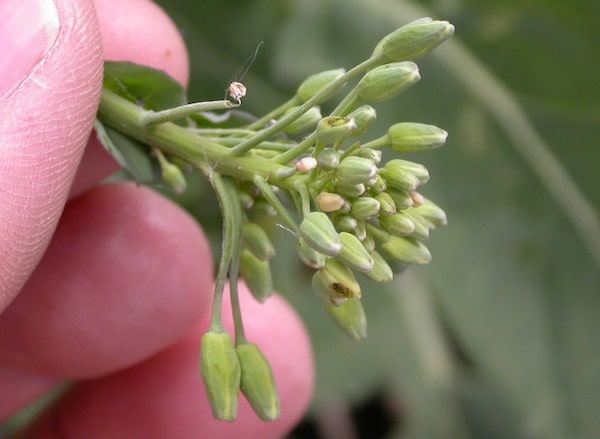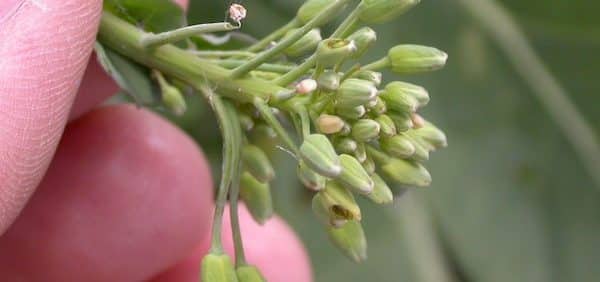
Bud damage and insects are being found together in some canola fields, but that does not mean insects are the primary reason for the damage. Take a moment to assess the damage before making unnecessary or poorly timed insecticide applications.
Key points to consider:
—There is no well documented case for spraying insecticide in the pre-bolting stage of canola.
—Many things can cause bud failure. Early buds in canola are extremely vulnerable to a wide array of stresses, including high temperatures, low temperatures (or an abrupt change between these two, which was experienced in the past week), extreme wind, drought, herbicides applied at off-label rates or staging, and insect feeding.
—If plants at the same stage of maturity show the same symptoms, this indicates a ‘flash’ or short term issue. A hot day followed by a very cool night can cause browning off of whole bud clusters. If new buds are forming and are in good shape, this supports a flash type of stress.
— Insect damage will not affect all buds in a cluster, even in very high populations. Every bud injured on main raceme is a sign of environmental stress.
—If the damage is from insects, there will be evidence of their feeding….
Cabbage seedpod weevils have chewing mouthparts so their damage appears as small holes chewed into the flower bud. Buds that are brown/yellow/white with no feeding wounds are not CSPW damage. More on cabbage seedpod weevil thresholds.
Lygus bugs have piercing mouthparts. Their damage is more subtle and difficult to separate from environmental stresses. Close inspection will show watery ooze on fresh bites or a pepper-like spot on older feeding marks. More on lygus thresholds.
Diamondback moth larvae will chew flower parts.
—Very high populations of cabbage seedpod weevils have been reported in other years and they did not cause the type of damage currently being attributed to them. It is unlikely they have caused the type of damage we’re seeing this year either, even if they’ve been spotted in a field. Ask yourself: If we have never seen a need to spray at the pre-bolting or bolting stages before, why is it necessary now?
—Spraying insecticide at the pre-bolting stage is not (or rarely) economical. Keep scouting and evaluate at the proper spray timing. For cabbage seedpod weevil, for example, this is at 15-20% flower and only if you find 20 or more per 10 sweeps.
—Spraying prior to bolting will probably result in the need to spray again if weevil pressure is high. This has been documented in field scale research plots.
—Canola plants can and do compensate for the loss of flower buds. This is well-documented..
—Five weevils in one flower cluster is not likely a true snapshot of the overall density in the field. Weevils are mating and will tend to be in groups in response to aggregation pheromones.
The bottom line: Be critical and look for the real causes behind the bud loss we are seeing in pre-bolting canola. Don’t jump to conclusions and blame the damage on insect feeding without weighing all the factors.
